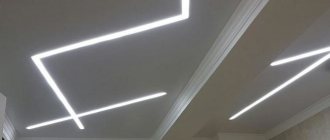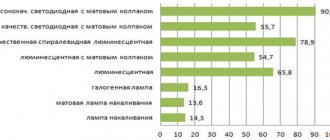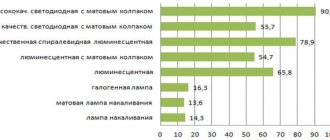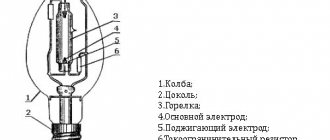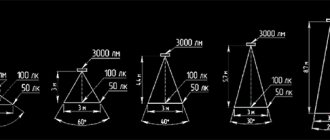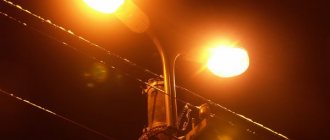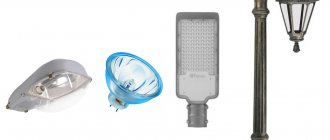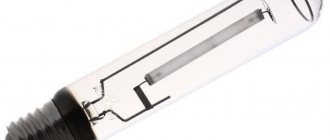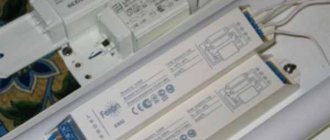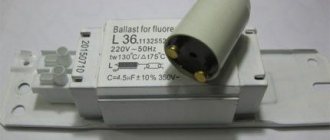The study of the behavior of electric discharge in various environments with the aim of creating a light source has been carried out since the end of the 19th century by scientists from many countries around the world. The first low-pressure mercury lamp, the design of which is almost identical to the modern one, was created in 1901 by engineer Peter Cooper-Hewitt. But it was only in 1938 that General Electric began serial production of fluorescent lamps.
In the USSR, such lamps first appeared in 1951, thanks to the efforts of a team of engineers led by physicist Valentin Aleksandrovich Fabrikant. The 36 W fluorescent lamp is one of the most popular lighting products. It is simple, cheap and reliable.
Design features and principle of operation
A 36 W lamp is an ordinary glass tube, the ends of which are sealed. The inside of the flask is treated with a special agent - a phosphor, which converts the resulting ultraviolet radiation into visible light. The tube is also filled with a mixture of argon and mercury gases. First, all the air is pumped out of the pipe. The current passes through a tungsten helix, which is coated with oxides to increase reliability. Nickel electrodes are connected to the ends of the spiral.
In order for the light bulb to light up, you need to apply an electric current. It increases the temperature of the coil, which causes a discharge. The resulting ultraviolet passes through the phosphor and the walls of the flask and turns into visible radiation at the output.
Inside the flask there is a mixture of different gases and vapors, which is plasma. It emits a stream of light in the visible and invisible regions of the spectrum. The phosphor converts invisible radiation into visible radiation, and as a result, the lamp can illuminate a certain area.
Thanks to this design and improved materials, the light bulb will consume less electricity than conventional lamps. If compared with an incandescent lamp, the amount of energy required will decrease several times.
Fluorescent lamp device
Operating principle
As the phosphor content changes, the color of the lamp glow . Substances such as calcium halophosphates and calcium-zinc orthophosphates are used as phosphors. In order for the device to turn on, it first needs to warm up its cathode. To do this, current flow or ion bombardment is used in a glow discharge with a high potential difference. Therefore, a device is used that includes a starter and a throttle.
When voltage is applied to the cathode, free electrons are emitted. The starter then breaks the warm-up circuit, while at the same time the throttle provides a voltage pulse. This impulse is enough to cause a breakdown of the gas in the lamp. The choke also limits the discharge current.
Fluorescent lamps are classified according to the following indicators:
- Discharge type : glow and arc.
- Radiation temperature : natural, warm, cold.
- By type of glass tube: tubular and shaped.
- In the direction of the light flux : non-directional and directional.
- Energy saving levels.
Types of fluorescent lamps
Any luminescent devices can be divided into two groups:
- General purpose lamps. These include lamps with power from 15 to 80 W.
- Special purpose. These include devices up to 15 W and over 80 W. They are called low-power and high-power, respectively.
General purpose lamps provide natural light.
Shapes of bulbs of compact fluorescent lamps
Devices can also be divided according to a number of technical indicators:
- According to light discharge: arc and smoldering.
- By radiation: with natural light, ultraviolet and different colors.
- According to the shape of the flask: linear tubes and curly models.
- Along the length of the tube.
- According to the base used: 14 mm and 27 mm.
- According to the distribution of light flux: directional and non-directional.
Types of illumination depending on the color temperature of light
Classification by color temperature:
- 2700-3400 K. These are warm shades. They have a calming and relaxing effect, which is why they are often placed in bedrooms.
- 3400-5600 K. Give natural radiation. Suitable for living rooms, kitchens and other types of rooms.
- 5600-6400 K. Cold tones. They increase tone and performance, which is why they are used in offices.
A 36 W luminescent source is analogous to a 40 W device. This is due to the fact that modern technologies allow the use of higher quality, reliable and modern materials.
Energy-saving devices use a high-quality phosphor layer and an improved design of the electrode block. Thanks to all these features, fluorescent light bulbs with lower wattage have a higher effective luminous flux. It is important to note that the tube diameter is reduced by 1.6 times.
Is a cool light lamp right for you?
Cool light looks harsh and bright. It is needed where a short-term “spike” of concentration and productivity is needed - for example, in laboratories and production facilities. Cold light brings a feeling of cleanliness, sterility and freshness, which is why it is often used in clinics. It is suitable for offices, study rooms, kitchens and corridors. Cool tones create a business atmosphere. In addition, they look good in black and white interiors, but with prolonged use they tire the eyes.
Marking of light sources
The 36 W fluorescent lamp has simple letter and number markings. For example, a 36w fluorescent lamp with the abbreviation LB-36 is deciphered as follows:
- L – lamp.
- B – white color.
- 36 – power, W.
There are also 36W fluorescent lamps with different markings:
- LTB. Warm white light. They have a barely noticeable pink tint.
- LD. Close to daylight.
- LDC – fluorescent lamps with different colors.
- LCB – cool white.
The given markings are used in Russian products. Foreign designation is different. It consists of three numbers and English words indicating the type of glow. Labeling may differ between different foreign manufacturers.
LB products are the most efficient in terms of output luminous flux compared to other devices of the same power.
What it is
Lamp LB 36 is a 36-watt low-pressure fluorescent lamp. It is one of the most popular models because it is simple, reliable and cheap. Fluorescent lamps with a power of 15-80 watts belong to the category of general-purpose lamps. Their main task is to imitate natural light.
Important! The modern analogue of a 36 V lamp is an outdated 40 V lamp. Modern technologies make it possible to reduce power without changing other characteristics
The name “Luminescent” is due to the fact that the glow of the light bulb comes from a layer of phosphor on the inner wall of the glass tube, and not from the heated gas inside. Luminescence is secondary radiation that appears from the action of a flow of positively infected ions.
The abbreviation stands for as follows:
- L - fluorescent light bulb;
- B - white.
There are other color abbreviations: D - daytime, E - natural, U - universal, HB - cool white, TB - warm white. The marking may also contain other letters: K (red), Z (green), G (blue), S (blue). Separately referred to as UV or ultraviolet.
A fluorescent lamp is a gas-charging light source. The glow is created by an electrical discharge in mercury vapor, which creates ultraviolet radiation. The LB operates from an AC power supply with a voltage of 127-220 V and a frequency of 50 Hz.
According to the color temperature of LB light bulbs, they can be:
- Warm white (2.7-3.4 thousand K). The color is soft, soothing and relaxing, with a yellowish tint;
- Natural white (3.4-5.6 thousand K). Cooler and sharper, brighter;
- Cool white (5.6-6.4 thousand K). It has a bluish tint, is cool and clear, and increases performance.
Specifications
36 watt lamp has the following characteristics:
- radiation brightness 6-11 cd/sq.m;
- ripple factor 23%;
- brightness and power increases with increasing rated voltage;
- service life from 4800 hours, average value is 12000 hours;
- base G13;
- flask diameter 26 mm;
- length of most part 12 cm;
- rated voltage 103 V.
The data given are average values. They may vary between different manufacturers and under specific operating conditions. The service life can be significantly reduced due to frequent switching on and off or high room humidity and low temperature. Therefore, it is important to choose the right location for installing the light source.
Lamp device
The device is a long glass tube. The light bulb consists of several parts:
How do ceiling fluorescent lamps work?
An elongated narrow flask made of quartz glass. The inside is coated with a white phosphor, which makes the lamp look opaque. To enhance the quality of the light flux, there can be several layers of phosphor (3 or 5). The air is pumped out of the tube, instead argon and a drop of mercury are pumped in, the latter turns into steam with increasing temperature;
A fluorescent lamp consists of several parts
Important! The pressure inside the bulb does not exceed 400 Pa, which is why they are called low-pressure lamps
- 2 bases with output contacts. They are located on both sides of the tube and are connected to the mains;
- Electrodes: they are soldered at both ends of the bulb. They are spiral-twisted tungsten wires and are additionally coated with barium or strontium salt oxide to protect and increase service life. Hard nickel electrodes are mounted parallel to the tungsten electrodes. They are connected at one end to tungsten.
Also for connection you need a choke - a ballast, without which the lamps will not work. Its task is to ensure the stability of the current at its variable value.
The principle of operation is to pass a charge through mercury vapor
Advantages and disadvantages
Fluorescent devices are inferior to LEDs, but are still often used for illumination. This is due to the positive qualities of a 36 W fluorescent light bulb:
- small dimensions and weight;
- wide scope of application;
- saving;
- large coverage area;
- extended spectrum of light;
- long service life;
- good efficiency;
- availability of analogues for various purposes and colors.
Light bulbs also have disadvantages:
- the presence of harmful substances in the device;
- difficulty of disposal;
- harm to human health and eyes;
- requires throttle to start;
- increase in cost;
- long startup;
- reduced service life due to frequent switching on and off.
The devices are actively used and replace outdated incandescent lamps and halogen devices.
Advantages
Production technologies are constantly being improved. Modern energy-saving fluorescent lamps use increasingly better luminescent layers. This made it possible to reduce their power, while simultaneously increasing the efficiency of the light flux, and also the diameter of the glass tube decreased by 1.6 times, which also affected its weight.
Let's consider the advantages of fluorescent lamps:
- high efficiency, savings, long service life;
- variety of color shades;
- wide spectral range;
- availability of colored and special flasks;
- large coverage area.
They consume 5–7 times less electricity than ordinary incandescent lamps. For example, a 20 W fluorescent lamp will give as much light as a 100 W incandescent lamp. In addition, they have a very long service life. In this regard, only an LED light bulb can compare with them and exceed these readings, but it has its own characteristics. They also make it possible to select bulbs that will provide the desired level of illumination. And its variety of color shades will make it easy to decorate the room.
Fluorescent lamps are used in medicine, being used as good lamps and as ultraviolet and bacterial devices. This capability is widely used in the food industry.
It is also very important that such a lamp can illuminate a fairly large area, so it has become indispensable for large rooms. Its minimum service life is 4800 hours, the technical specifications above indicate 12 thousand hours - this is the average value, the maximum is 20,000 hours, but it depends on the number of switches on and off, so it will last less in public places.
Flaws
Despite such great advantages of fluorescent lamps, they can be harmful to health, so such lamps are not recommended for installation at home or outdoors. If such a device breaks, it can poison the room, area and air over a long distance. The reason for this is mercury. That is why used flasks must be submitted for recycling.
Another disadvantage of fluorescent bulbs is their flickering, which is easily caused by the slightest malfunction. It can negatively affect vision and cause headaches. Therefore, it is necessary to ensure that the malfunction is resolved in a timely manner or replace the tube with a new one.
To start the lamp you need a choke, which complicates the design and affects the price.
Prices
36 W fluorescent lamps are economical, provide high-quality bright color and create a pleasant working atmosphere, their prices are low and start from 60 rubles
When choosing them, buyers pay more attention to the need for room lighting. The lamps for them are also very cheap, so when buying a lamp, they pay more attention to the required quality rather than to the price
Lamps are supplied in boxes of 25 pieces - this is the minimum quantity. You can buy one or more in retail stores, where they are packaged in original boxes. The product unit weighs only 0.17 kg
The flask is very light, long and fragile, so care must be taken when transporting it
Areas of application
Fluorescent lamps have a wide range of uses. They can create all types of lighting in residential premises, offices, fill industrial premises with light, and create illuminations.
The devices have also found their application in medicine. Using special fillers, bactericidal and ultraviolet lamps can be created. They are used to clean the room from bacteria and germs. Lamps can also be installed in shops, warehouses and enterprises for the purpose of disinfecting premises.
The ability to create sources of different colors has led to the use of fluorescent light bulbs in entertainment, show business, and advertising.
Types of fluorescent lamps
All standard fluorescent lamps are divided into two main types - high and low pressure, which determine the differences and design features of each of them. A description of each of them is included in the operating instructions.
The first option is represented by DRL lamps, which are widely used in street lamps. They are characterized by high power and low color rendering, which is why they are used in large areas where high quality light is not required. There are products with increased light output and different colors. They are used as powerful point light sources and decorative lighting that highlight the architectural elements of buildings.
Most of all, the low-pressure fluorescent lamp turned out to be in demand, which is used everywhere - in everyday life and in production. Mostly, these are cylindrical-shaped products that successfully replace traditional incandescent lamps. Currently, the electronics market is increasingly filled with compact fluorescent lamps. Regardless of the design, they all work together with electromagnetic or electronic ballasts that reduce the ripple factor. The latter option is a miniature electronic circuit that can fit in a lamp base.
Recommendations for selection
Lamps are selected for a specific type of lamp. This obliges the buyer to pay attention to its characteristics. Particular care should be taken when choosing fluorescent lamps. For example, the Russian lamp LB 36 has a length of 1200 mm and is suitable for installation in a corresponding device. A 35 W device of similar power from the German company OSRAM has a different length - 1449 mm. The length of the tube must be taken into account when purchasing.
Attention is also paid to the diameter of the flask. The standard is 16 mm, but you can find devices for 12 mm, 25 mm and other sizes. The luminous flux directly depends on the diameter. In lamps you can use a tube with the same base (G13) with a smaller diameter, but not with a larger one.
Fluorescent lamps have pulsations, which have a negative impact on health. To reduce the negative impact, you should give preference to high-quality, expensive and proven devices purchased from a professional store. A lamp of unknown manufacture is made from low-quality components, and this directly affects the flickering.
More details about the lamp type
This is a tubular lamp with a T8 bulb. The diameter of the tube is 26 mm, and there is a G13 pin base at both ends. The base pins are 13mm apart.
Attention! The length of the lamp body with base (without pins) is 1200 mm, and the power is 36 W. Please make sure these options are suitable for your luminaire before purchasing.
Most often, these linear lamps are used in public buildings (offices, factories, schools) in luminaires built into modular ceilings. The average operating time of such lamps is about 10,000 hours.
Principle of operation
These lamps use mercury; when heated, an electrical discharge is created in the vapor of this metal, which contributes to the formation of ultraviolet radiation . Further, a special substance called phosphor absorbs this radiation, resulting in light being produced in a spectrum familiar to the human eye. This is how it should be ideally.
In fact, the shade of lighting is constantly criticized by users of these lamps precisely for the unnatural color. You can philosophize a little about physical laws, remember that from this point of view, color does not exist without light at all, and therefore, from the point of view of this science, fluorescent lamps really paint everything in natural colors. Basically, all this is nitpicking. The shades of the illuminated objects do not change so much as to seriously perceive this moment as an inconvenience (except for certain specific areas of activity), and the savings in comparison with traditional ones are very noticeable.
